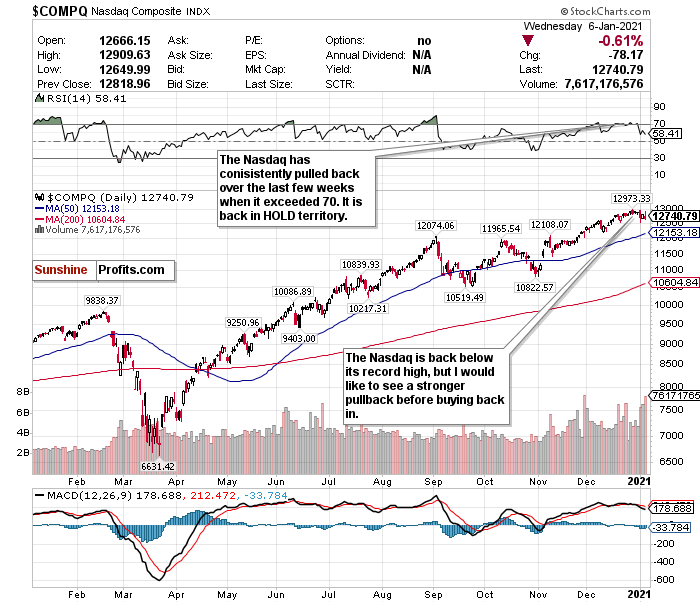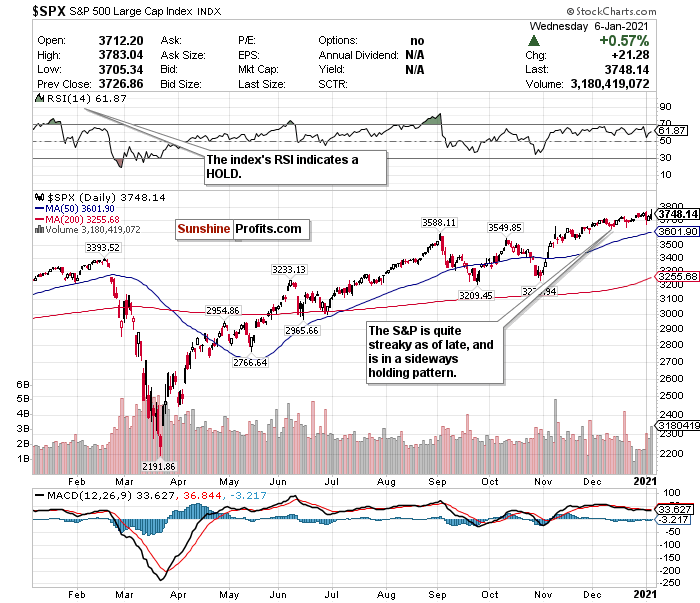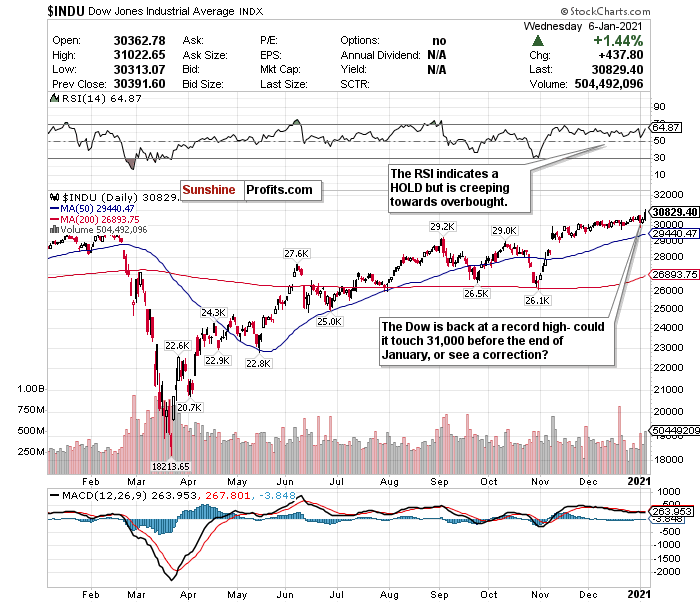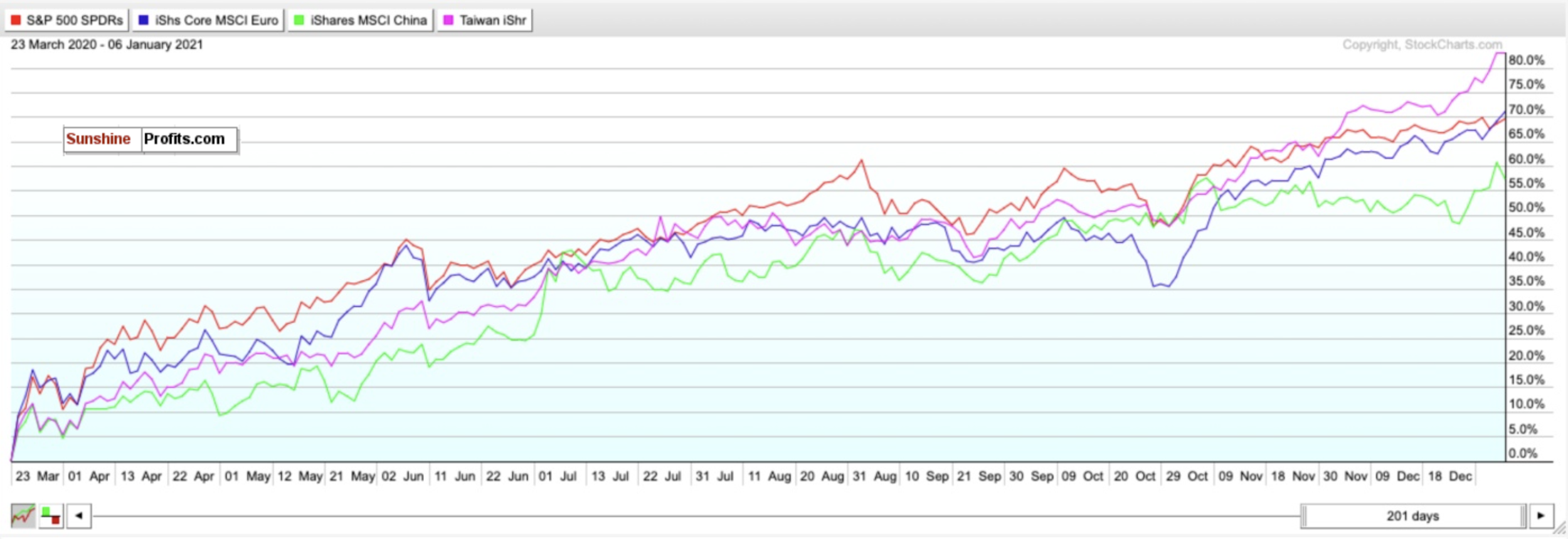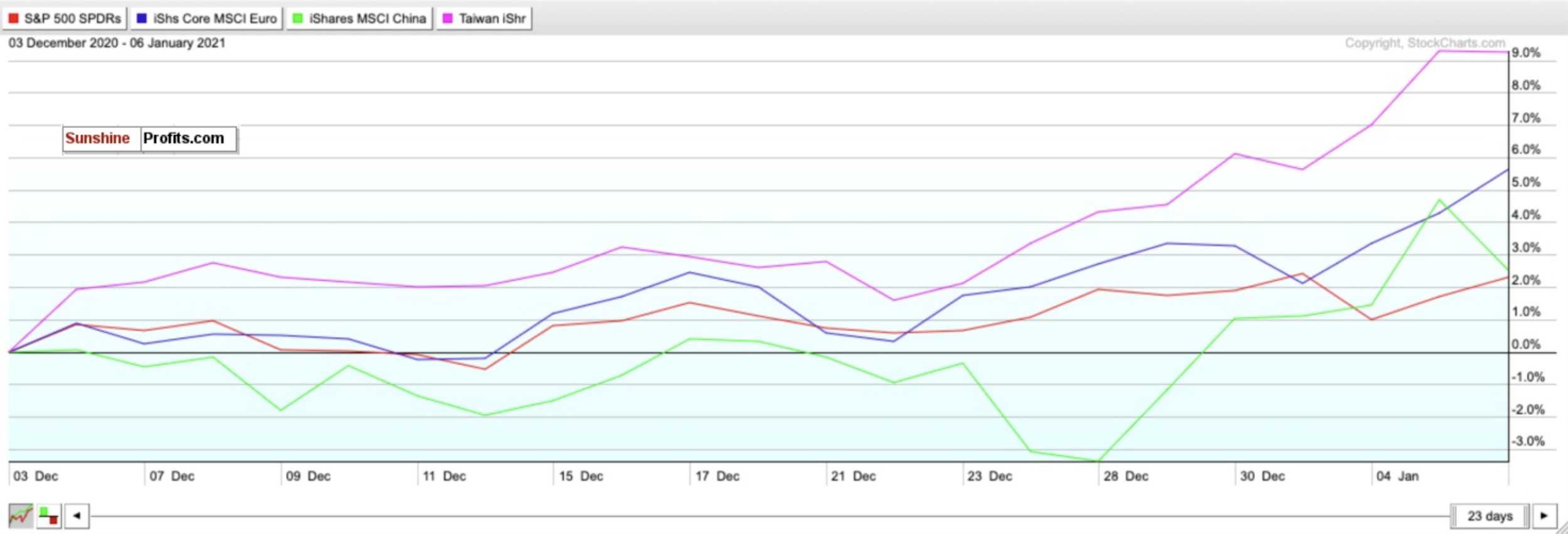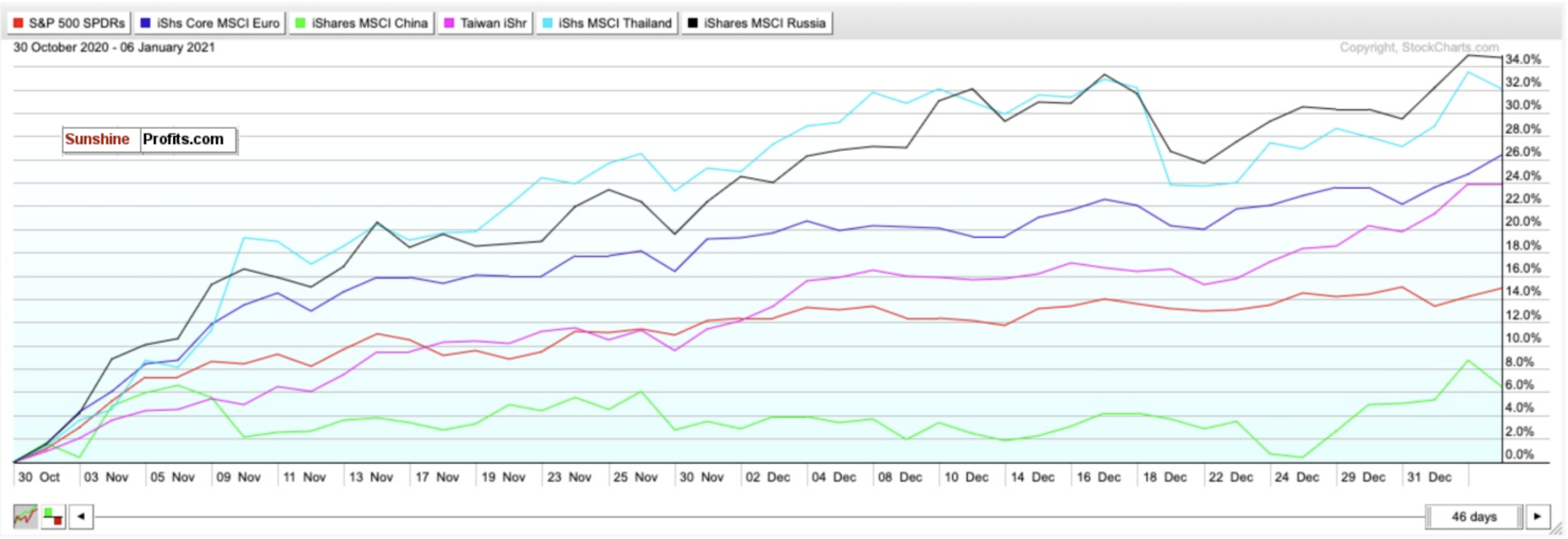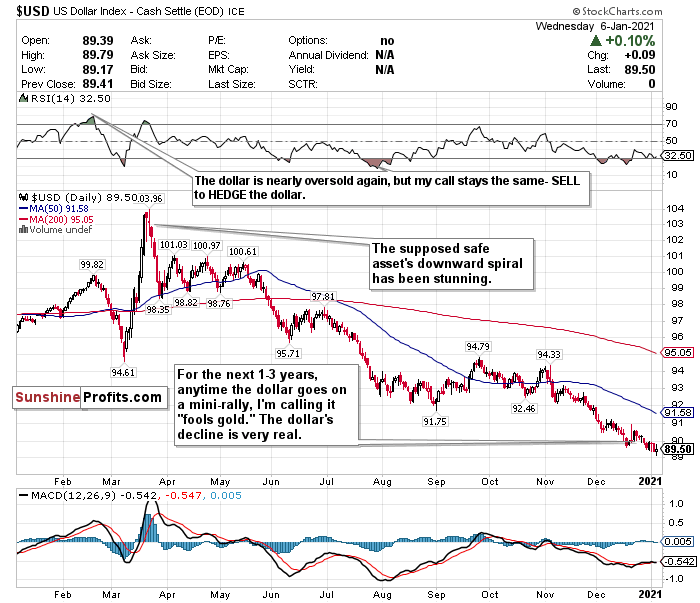In a news-filled day, the Dow Jones hit an all-time high on Wednesday (Jan. 6), despite unprecedented unrest taking place in Washington D.C.
News Recap
- The Dow climbed 438 points or 1.4% and briefly rose more than 600 points earlier in the day. The S&P 500 also gained 0.6% and hit an intraday record, while the Nasdaq fell 0.6%. The small-cap Russell 2000 surged by nearly 4%.
- The day began with investors focused on the Georgia U.S. Senate special election runoff. Democrat Raphael Warnock defeated incumbent Republican Kelly Loeffler, with other Democrat Jon Ossoff announced as the winner over incumbent Republican Sen. David Perdue later in the day.
- With a Democrat sweep in Georgia, the party now has control of the Senate. Although it is a 50-50 split (with two independents) in the Senate, both Democrats win, they have full control because Vice President-elect Kamala Harris will serve as the tiebreaker vote.
- Many believe that because President-elect Biden, a Democrat, has a House and Senate under Democrat control, he could more easily pass higher taxes and progressive policies that may hurt the market. On the other hand, others believe that this Democrat sweep could bring into effect a larger and quicker stimulus relief bill.
- The real news of the day was what happened at the U.S. Capitol building. After President Trump (and his family) led a “Stop the Steal” rally in Washington, D.C. to protest Congress’ certification of Joe Biden as the next president, angry MAGA supporters did the unthinkable and stormed the Capitol.
- Wednesday (Jan. 6) was the first time since 1814 that the Capitol building was physically breached by hostile actors.
- The invasion of the Capitol occurred after Vice President Mike Pence rejected President Trump’s calls to block Joe Biden’s election confirmation. Shortly after, the Capitol went into full lockdown.
- Later that night, the Capitol was secured and Congress reconvened to officially certify Biden as the president. The CBOE Volatility Index (VIX) moved higher due to the unrest at the Capitol.
- Caterpillar (CAT) surged 5.5%, while big banks such as JPMorgan Chase (JPM) and Bank of America (BAC) gained 4.7% and 6.3%, respectively. Other names and sectors that could be aided by Biden’s agenda rose as well such as the Invesco Solar ETF (TAN) which boomed 8.4%.
- Tech lagged on the day due to fears of higher taxes and higher stimulus potential. Facebook (FB) and Amazon (AMZN) each fell more than 2%, while Netflix (NFLX) dipped 3.9%.
- The 10-year Treasury note yield topped 1% for the first time since March.
What a newsworthy day Wednesday (Jan. 6) was. What started as a day focused on Senate runoff elections with the balance of Senate power at stake, ended with President-elect Biden being officially confirmed as the next president. But in between? A mob took over the capitol building! Did you ever think you would read that sentence in your lifetime?
Love him or hate him, President Trump is an eccentric character to put it lightly. Scorned, and still convinced that he won the election, Trump and his bruised ego whipped his supporters into a frenzy during a “Stop the Steal” rally and encouraged them to march towards the Capitol and make their voices heard. Somehow the protest turned into a storming of the Capitol after Vice President Mike Pence refused to overturn the election. Pence was later ushered out of the Senate and the Capitol went into lockdown.
What’s truly shocking here is that the markets still went up! In fact, the Dow hit yet ANOTHER all-time high! Whether you like it or not, this has to give you some sort of faith in the resiliency of capitalism,
The results of the Georgia election can be credited for the market surge.
Although some sectors plummeted due to fears of higher taxes and stricter regulations, with full Democrat control of the Presidency, Senate, and House, there is clarity for one, and expectations of further spending and government stimulus.
Goldman Sachs expects another big stimulus package of around $600 billion. While this could be bad for the national debt and have long-term consequences, in the short-term, it could send the economy heating. Small-cap stocks surged as a result.
I still believe that there will be a short-term tug of war between good news and bad news. Many of these moves upwards or downwards are based on emotion and sentiment, and I believe there could be some serious volatility in the near-term. Although markets on Wednesday (Jan. 6) may have been overly excited from the “Blue Wave” thanks to Georgia, consider this: the Capitol was invaded and the pandemic is still wreaking havoc! Even though the markets gained and the 10-year treasury ticked above 1% for the first time since March, the VIX still rose which means that fear is on the rise.
There was no pullback to end 2020 as I anticipated, but I still believe that markets have overheated in the short-term, and that between now and the end of Q1 2020 a correction could happen.
Carl Icahn seemingly agrees with me, and told CNBC on Monday (Jan. 4) that “in my day I’ve seen a lot of wild rallies with a lot of mispriced stocks, but there is one thing they all have in common. Eventually they hit a wall and go into a major painful correction.”
National Securities’ chief market strategist Art Hogan also believes that we could see a 5%-8% pullback as early as this month.
I believe though that corrections are healthy and could be a good thing. Corrections happen way more often than people realize. Only twice in the last 38 years have we had years WITHOUT a correction (1995 and 2017). I believe we are overdue for one since there has not been one since the lows of March 2020. This is healthy market behavior and could be a very good buying opportunity for what I believe will be a great second half of the year.
While there will certainly be short-term bumps in the road, I love the outlook in the mid-term and long-term once vaccines become more widely available. The pandemic is awful right now, and these new infectious strains out of the U.K. and South Africa are quite concerning. But despite this, I believe the positive manufacturing data released on Tuesday (Jan. 5) is a step in the right direction, especially considering all the restrictions that most countries are living through.
The consensus is that 2021 could be a strong year for stocks. According to a CNBC survey which polled more than 100 chief investment officers and portfolio managers, two-thirds of respondents said the Dow Jones will most likely finish 2021 at 35,000, while five percent also said that the index could climb to 40,000.
Therefore, to sum it up:
While there is long-term optimism, there are short-term concerns. A short-term correction between now and Q1 2021 is very possible. But I do not believe, with conviction, that a correction above ~20% leading to a bear market will happen.
The Nasdaq is No Longer Overbought...is a Big Correction Coming?
I changed my short-term call on the Nasdaq to a SELL on December 18th. While I did not say to fully exit positions, I said that now would be a good time to trim some profits before an eventual pullback. While the Nasdaq has been largely flat since, it is no longer at a record high and is no longer overbought according to its RSI. It also lagged significantly behind the Dow, S&P, and Russell on Wednesday (Jan. 6) due to fears of higher taxes under a Democrat dominated Congress.
Tech can rally at any time and witness a plunge at any time. Truly, as with small-caps, I believe the sector could move sideways before seeing a correction in the early part of 2021 is inevitable.
Additionally, while an overbought RSI does not automatically mean a trend reversal, with the Nasdaq, always keep a close eye on this.
The Nasdaq pulled back on December 9th after it exceeded an RSI of 70, and briefly pulled back again after passing 70 again two weeks ago. We exceeded a 70 RSI again before the new year, and what happened on the first trading day of 2021? A decline of 1.47%. I believe another decline is imminent after another short-term rally comes.
Although there are also tailwinds for tech, I have more doubts after the Democrats swept Georgia. Tech has also overheated as it is, and there are signs of a bubble. Do not let anyone tell you “this time is different” if fears of the dot-com bubble are discussed. History repeats itself, especially in markets. I have many concerns about tech valuations and their astoundingly inflated levels. The recent IPOs of DoorDash (DASH) and AirBnB (ABNB) reflect this.
Do what you can though to research tech companies that have innovator and disruptor potential. There is always an opportunity somewhere. While tech has overheated in the short-term, my optimism and bullish thoughts for 2021 have not changed. I hope tech pulls back closer to its 50-day moving average for some quality long-term buying opportunities.
For now, because the RSI is back in HOLD territory, and I foresee a near-term return to the stay-at-home trade, I’m switching my call from SELL back to HOLD.
But the second the RSI goes back above 70, I’m switching back to SELL. There are clear patterns here.
I do not believe that now is the time to buy back into tech, but please remember that tech can be very helpful to own on pessimistic days because of all the “stay-at-home” names.
For an ETF that attempts to directly correlate with the performance of the NASDAQ, the Invesco QQQ ETF (QQQ) is a good option.
The S&P Has Long-term Upside Mixed with Uncertainty
The S&P 500 has been quite streaky as of late and reflects the broader tug-of-war between good and bad news. The large-cap, blue-chip index, seemingly goes on multiple day winning streaks and losing streaks on a weekly basis.
Although it began 2021 at a record high, the index saw its worst one-day sell-off since October on Monday (Jan. 4). Although the index has recovered since, I believe more sell-offs could be on the horizon. While I always cheer stocks going up and hitting records, I also want buying opportunities. I would like to see this blue-chip large-cap index drop to around 3600 or below before making a BUY call for the long-term. For now, my near-term outlook is murky, but there could be a short-term pop if more stimulus passes.
Although the RSI is showing a HOLD, I believe that a short-term correction could inevitably occur by the end of Q1 2021.
While many analysts and strategists believe this short-term uncertainty is worth it for long-term potential, (and I tend to agree), I would prefer a sharper correction to initiate S&P exposure at a discount. There is clear upside for the second half of 2021. I would just prefer to maximize the upside if I believe that it’s possible to buy the ETF at a lower level.
Some analysts believe the S&P could have up to a 20% upside in 2021, while others caution against an overheating index. According to another survey of market strategists conducted by CNBC, a narrow majority believe that U.S. stocks will continue to rally into 2021, with the S&P 500 rising between 8% and 22% next year from these current levels. This very well could be the case- but I believe most of this will happen in the next 6-12 months rather than 1-3 months.
For now, I have the S&P 500 in a HOLD category.
For an ETF that attempts to directly correlate with the performance of the S&P, the SPDR S&P ETF (SPY) is a good option.
Does the Dow Approach 31,500 or 29,000 Before Mid-2021?
Any time I seemingly question if the Dow has more room to run towards record highs, it hits them. It defies logic, frankly. If the Dow can still hit all-time highs despite the Capitol building being invaded by hooligans, then what can stop the index?
I have many short-term questions for the Dow Jones, and believe it is just as likely to touch 29,000 as it is 31,500 before March.
After trading as low as around 29,650 at one point before the new year (Dec. 21), the Dow has remained firmly above 30,000 for weeks.
Yet despite some long-term optimism, for now, my short-term questions take precedence. I don’t like how COVID-19 is trending (who does?), I am disappointed in the vaccine roll-out, and I am concerned about short-term economic headwinds.
While I think a 35,000 call to close out 2021 is a bit aggressive, I do believe that the second half of 2021 could show robust gains for the index.
With so much uncertainty and the RSI creeping towards overbought, the call on the Dow stays a HOLD.
This is a very challenging time to make a call on the Dow with conviction. But one thing I do believe is that if and when there is a drop in the index, it will not be strong and sharply relative to the gains since March 2020. I believe that it is more likely than not that we will be in a sideways holding pattern until vaccines are available to the general public by mid-2021.
For an ETF that attempts to directly correlate with the performance of the Dow, the SPDR Dow Jones ETF (DIA) is a strong option.
Mid-Term/Long-Term
Taiwan and Others for Emerging Market Exposure - Not China
Emerging markets in both the medium-term and long-term have robust potential. But at this point, it is very country-specific.
Although China garners most of the attention as a so-called “emerging market,” it has not been the top performer since markets bottomed on March 23rd and is no longer the top option for 2021. If you want China’s regional upside with less geopolitical risks or pandemic recovery baked-in, look at the Taiwan iShares ETF (EWT). Taiwan has outperformed China in the short-term, medium-term, and long-term.
As seen in the chart below, ever since I first called the Taiwan ETF (IWT) a BUY on December 3rd it has outperformed the MSCI China ETF (MCHI), the SPDR S&P ETF (SPY), and iShares Core Europe ETF (IEUR).
The EWT has gained 9.25% while the MSCI China ETF (MCHI) has barely gained 2.5%. The Taiwan ETF has also outperformed the SPY S&P 500 ETF and the IEUR ETF which tracks Europe.
China may have handled the pandemic better than other countries and continues to demonstrate its ability to handle COVID-19’s economic shocks. But keep in mind that this is a regional victory, not just China.
There are two other emerging markets I am very bullish on for 2021 as well - Thailand and Russia. According to a Bloomberg study from December 16th based on 11 indicators of economic and financial performance, Thailand topped the list due to solid reserves and a high potential for portfolio inflows, while Russia scored second due to robust external accounts, a strong fiscal profile, and an undervalued currency.
Do you know who scored poorly on this list? China. High expectations were largely already baked in during its 2020 recovery, and there is little upside.
Do you also know who significantly outperformed the Taiwan ETF (IWT), the MSCI China ETF (MCHI), the SPDR S&P ETF (SPY), and iShares Core Europe ETF (IEUR) since October 30th? The iShares MSCI Thailand ETF (THD) and the iShares MSCI Russia ETF (ERUS).
For broad exposure to Emerging Markets, you will want to BUY the iShares MSCI Emerging Index Fund (EEM), for exposure to a regional economic power without the geopolitical risks of China, you will want to BUY the iShares MSCI Taiwan ETF (EWT). Consider the iShares MSCI Thailand ETF (THD) and the iShares MSCI Russia ETF (ERUS) as well for 2021 upside.
The Dollar is Below 90 - and Could Fall Further
Although the U.S. Dollar ticked up somewhat on Wednesday (Jan. 6), I simply do not have faith in the U.S. Dollar as a safe asset. I still am calling out the dollar’s weakness after several weeks despite its low levels. I expect the decline to continue as well thanks to a dovish Fed.
Any time the U.S. Dollar rallies, I am calling it “fool’s gold.” Since I started doing these newsletters about a month ago, I have consistently said that any minor rally the dollar would experience would be a mirage. Since it briefly pierced the 91-level on December 9th, it has fallen nearly 1.75%. Despite the greenback experiencing another mini-rally and nearly piercing the 91-level again on December 22, I remained steadfast in my bearish outlook of the dollar. Since the open on December 23rd, the U.S. Dollar has declined nearly another 1%. I believed that it would drop back below 90 before the new year, and here we are to start off 2021 with the dollar at 89.50.
Since hitting a nearly 3-year high on March 20th, the dollar has plunged nearly 13.8% while emerging markets, foreign currencies, precious metals, and cryptocurrencies continue to strengthen. Gold for example reached an 8-week high on Tuesday (Jan. 5), and Bitcoin surged to another all-time high over the $37,000 level on Wednesday (Jan 6)
On days when COVID-19 fears outweigh any other positive sentiments, dollar exposure might be good to have since it is a safe haven. But in my view, you can do a whole lot better than the U.S. dollar for safety.
I have too many doubts on the effect of interest rates this low for this long, government stimulus, strengthening of emerging markets, and inflation to be remotely bullish on the dollar’s prospects over the next 1-3 years. Meanwhile, the U.S. has $27 trillion of debt, and it’s not going down anytime soon.
Another headwind to consider for the dollar is the Georgia Senate election. If Democrats sweep, there could be more aggressive stimulus in the near term. With Democrats controlling both the House and the Senate, more stimulus could be bearish for the dollar.
Additionally, according to The Sevens Report, if the dollar falls below 89.13, this could potentially raise the prospect of a further 10.5% decline to the next support level of 79.78 reached in April 2014. With the dollar now at 89.41, we are coming dangerously close.
The dollar’s RSI is also nearly oversold once again and is trading significantly below both its 50-day and 200-day moving averages.
For now, where possible, HEDGE OR SELL USD exposure.
Pay Very Close Attention to Inflation
Pay very close attention to the possible return of inflation within the next 6-12 months. The Fed has said it will allow the GDP to heat up, and it may overshoot in the medium-term as a result. Although JP Morgan and Goldman Sachs have cut their GDP growth estimates for Q1 2021, pay close attention to what happens in Q2 and Q3 once vaccines begin to be rolled out on a massive scale. It is only inevitable that inflation will return with the Fed’s policy and projected economic recovery by mid-2021.
If you are looking to the future to hedge against inflation, look into TIPS, commodities, gold, and potentially some REITs.
In the mid-term, I have BUY calls on the SPDR TIPS ETF (SPIP), the Invesco Optimum Yield Diversified Commodity Strategy No K-1 ETF (PDBC), the SPDR Gold Shares ETF (GLD), and the iShares Cohen & Steers REIT ETF (ICF).
Long-Term
There is so much to worry about in the short-term. But I believe that economic stimulus and the progress made with the vaccine(s) bodes well for the second half of 2021. We may be at the beginning of the end of the pandemic. But over the next 1-3 months, this could be a very bumpy ride back. Projections for the economy, the markets, and the pandemic are so all over the place right now.
There does seem to be one consensus though: 2021 could be a big year for stocks.
I have a very good feeling about stocks, especially small-caps, value stocks, and cyclicals. I just have a much better feeling for them in the second half of 2021. I almost hope we see a correction within the first three months of 2021. This could be a very strong buying opportunity.
Summary
While the current headwinds are very concerning, I am optimistic for the second half of 2021. The path there could be bumpy though.
Until COVID-19 is eradicated, there will inevitably be a tug of war between optimism and pessimism. Additionally, there are some short-term question marks with these Georgia results.
I believe that a short-term correction to start 2021 is inevitable. But do not let this scare you. Please remember that corrections are NORMAL and markets are forward-looking instruments that look 6-12 months down the road. Although it is very plausible that there could be some short-term uncertainty and volatility, use this as a time to find buying opportunities for the second half of 2021. Do not get caught up in fear if there is a correction.
I do not believe a crash like the one we saw in March is on the horizon, but a pullback of some sort is coming. Do not be fearful though. Since markets bottomed on March 23rd, here are how the ETFs tracking the indices have performed: Russell 2000 (IWM) up 107.65%. Nasdaq (QQQ) up 81.32%. S&P 500 (SPY) up 69.68%. Dow Jones (DIA) up 67.77%.
In the long-term, markets always end up moving higher and are focused on the future rather than the present.
To sum up all our calls, in the short-term I have a SELL call for:
- iShares Russell 2000 ETF (IWM) (but do not fully exit positions, just trim profits)
I have a HOLD call for:
- Invesco QQQ ETF (QQQ)
- the SPDR S&P ETF (SPY),
- SPDR Dow Jones ETF (DIA)
I also have a long-term STRONG BUY call for:
- iShares Russell 2000 ETF (IWM) BUT IF AND WHEN IT PULLS BACK
For all these ETFs, I am more bullish in the long-term for the second half of 2021.
For the mid-term and long-term, I recommend selling or hedging the US Dollar, and gaining exposure into emerging markets.
I have BUY calls on:
- The iShares MSCI Emerging Index Fund (EEM),
- the iShares MSCI Taiwan ETF (EWT),
- the iShares MSCI Thailand ETF (THD), and
- the iShares MSCI Russia ETF (ERUS).
Additionally, because I foresee inflation returning as early as mid to late 2021…
I also have BUY calls on:
- The SPDR TIPS ETF (SPIP),
- the Invesco Optimum Yield Diversified Commodity Strategy No K-1 ETF (PDBC)
- the SPDR Gold Shares ETF (GLD), and
- the iShares Cohen & Steers REIT ETF (ICF)
Thank you.
Matthew Levy, CFA
Stock Trading Strategist


